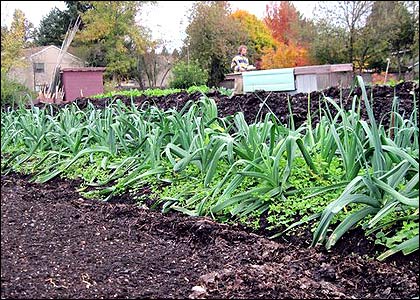
Don’t Stop Now
We can still plant garlic — and tulips
 |
| Behind the leeks is a raised bed ready to be tilled |
November is all about leaves. Landscape maintenance crews wear themselves out making landscapes neat — neater than they need to be, of course. Certainly, smothering layers of leaves need to be removed from paths, lawns, evergreen shrubs and non-dormant perennials. In our damp and relatively mild climate, things can rot under that soggy blanket. And in gardens where root vine weevils hang out, removing the leaf litter is a wise precaution. Otherwise, leave fallen leaves where they come to rest under trees and shrubs.
Excess leaves can be layered with kitchen and green waste in a compost heap, or left to rot in a heap of their own, with a little all purpose fertilizer to speed things up. You can also put the damp leaves in plastic bags, punch some holes to let the earthworms in, and throw the bags under a deck or in an inconspicuous corner. It takes about a year for the worms to break leaves down. Heavy duty bags can be used again and again.
Unless we have a very wet fall, it’s possible to continue cleaning out vegetable beds and preparing the soil for early spring planting. My neighbors recently screened the soil in their raised beds, laid a few inches of nice clean straw over the soil and then covered the beds with sheets of heavy grade plastic, carefully tucked in. Come February, they should have some nice, dry and warming soil to plant in.
Bring in any carrots you haven’t eaten so voles and slugs don’t get them, and consider covering salad leaf crops with improvised cloches. Pull yellowed lower leaves off kale plants, and mulch over the roots. If soil conditions are still good in your garden, it may not be too late to start a row of edible fava beans or, for that matter, a fava cover crop. Merry Bradley, Grassroots Garden coordinator for Food for Lane County, plants garlic in November. Until then, she says, there’s way too much else to do. She’s even planted garlic as late as December.
Speaking of leaves, I dropped by the Grassroots Garden recently, to see what was growing and to check out the annual renovation of empty planting beds, now well under way. Over a decade or so, Bradley has transformed the soil there from heavy clay loam to a black soufflé that grows cabbages the size of basketballs and is plantable in all seasons.
Volunteers dig out the old leaves that surface the paths between the long raised beds and pile them on top of the beds, which are leveled out again and then tilled to velvety smoothness. The paths between are filled with a fresh layer of leaves.
Planting trees and shrubs can continue through the winter in well drained soil, if you can find the plants you want. Small local nurseries are among the best sources. It’s a little late to plant perennials, except in the warmest gardens. Bulbs are an exception. Earlier planting is best for the small bulbs such as snowdrop and crocus. If you missed the boat, wait until late winter or early spring, when many garden centers offer growing bulbs in pots. That’s a good time to dig, divide and replant most small bulbs in your own garden, too.
Larger bulbs are a bit more tolerant of sitting around on shelves in warm stores. Bulbs often go on sale November. Tulips are the best value, because November is definitely not too late to plant them. Same with ornamental onions. Daffodils, however, are more marginal. Pass by any bulbs that have conspicuous shoots, and squeeze bulbs gently to make sure they are still very firm. It’s usually easy to see if a tulip bulb is withered or moldy, but it isn’t quite as obvious with daffodils.
Tulips do well in containers, but if you pot them up this late, the pots should be protected from freezing until the bulbs have had a chance to root. If you’d like to get more than one year of bloom from tulips, feed them in spring while the foliage is growing. When they have bloomed, you can plant the bulbs in the garden or save the pot, with soil, bulbs and all, in a shady spot through next summer. Bring it out again in fall to bloom a second year. After that it’s best to shake the dry bulbs out and sort them, planting just the largest bulbs in the garden or in fresh potting soil. For longest life in the garden, plant tulips deeply in very well-drained soil, or in places where they won’t get much summer water.
Rachel Foster of Eugene is a writer and garden consultant. She can be reached at rfoster@efn.org
|
|
|||||||
|
|
|||||||
|
Table of Contents | News | Views | Blogs | Calendar | Film | Music | Culture | Classifieds | Personals |
|||||||
Help keep truly independent
local news alive!
As the year wraps up, we’re reminded — again — that independent local news doesn’t just magically appear. It exists because this community insists on having a watchdog, a megaphone and occasionally a thorn in someone’s side.
Over the past two years, you helped us regroup and get back to doing what we do best: reporting with heart, backbone, and zero corporate nonsense.
If you want to keep Eugene Weekly free and fearless… this is the moment.